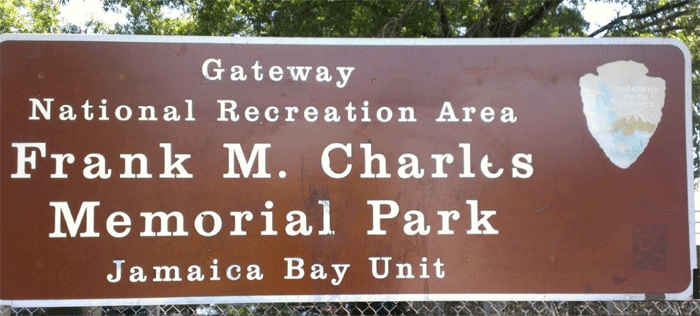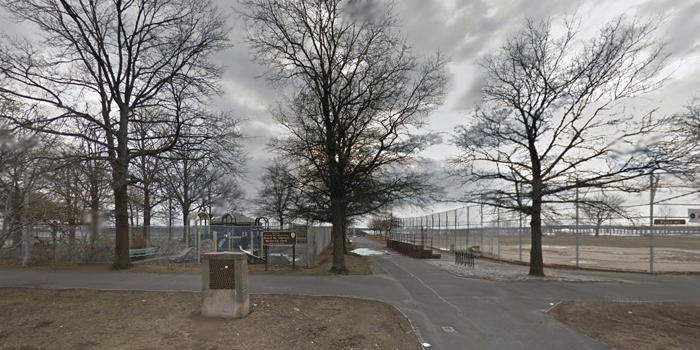
Courtesy Google Images
Local national recreation area still in poor condition despite local advocates’ fight for improvements.
By Lee Landor
[Note: This article originally appeared in the Queens Chronicle on July 10, 2008. This content is the rightful property of the Queens Chronicle. Photos were not immediately available.]
Most people wouldn’t be happy to see rain on the Fourth of July, but Dorothy McCloskey almost breathed a sigh of relief when she saw cloudy skies on Independence Day.
This meant there wouldn’t be hordes of people milling about Howard Beach’s Frank M. Charles Memorial Park, which in turn meant she would find less litter, overflowing trash cans and graffiti there the morning of July 8 — the day the NY Junior Tennis League program began its six-week season for the fourth consecutive year.
McCloskey, president of the Friends of Charles Park Committee and director of the league program she brought to Howard Beach in 2004, has learned what to expect at the park after 13 years of battling with its operator — Gateway National Park —over insufficient maintenance and lack of park rangers. Without enforcement, rowdy crowds visiting the national park tend to forget how to obey rules and leave the recreation area in an unsightly state. Although McCloskey’s primary focus is getting Gateway to cooperate, she also had one message for fellow park goers: “This is a natural wildlife preserve. We can’t afford to destroy it.”
But even without rowdy visitors, Charles Park appears neglected. McCloskey’s crew of 65 tennis students gathered on the tennis courts early Tuesday morning only to find the usual: hundreds of broken shells dropped by seagulls flying overhead covered the deteriorating courts. McCloskey wasn’t surprised to see that Gateway’s maintenance staff had neither swept nor weeded the courts, which are in desperate need of resurfacing.
But she happily announced to her students and their parents that, after four years of complaints from the Friends of Charles Park Committee, the park service had replaced all five nets on the tennis court and the wind screens on the fence surrounding it.
With children as young as 6 playing on the courts, McCloskey was worried the sharp and slippery broken shells would cut their legs or send them sliding across the court. “We need at least six or seven sweepers to get the courts in a useable condition,” she said, adding that they need to be swept weekly. That they aren’t is frustrating, but it does not deter McCloskey’s program from using the courts five days a week from 9 a.m. to noon.
She is determined to make good use of the $25,000 provided for the free tennis program by a number of sponsors, including Congressmen Anthony Weiner and Gregory Meeks, state Sen. Serphin Maltese, Assemblywoman Audrey Pheffer and City Councilman Joseph Addabbo Jr. Gateway National Park is also a sponsor, but “the good that they do is outweighed because they can’t seem to get a hold on the maintenance,” which, at best, is inconsistent, McCloskey said.
One example of such inconsistency is the park’s handling of overgrown shrubbery, which encroached on benches and poked through holes in the chainlink fence surrounding the tennis courts, posing what McCloskey considered to be a danger to children. After at least four months of hearing complaints about the dense bushes and requests to trim it, the park service responded by completely cutting down portions of different bushes and leaving others untouched. Like a bad haircut, the unevenness and asymmetry of the shearing left some areas once hidden by lush brush sitting baldly in the sun.
Gateway’s fickle management also ordered maintenance staff to paint over graffiti on a locked shed near the tennis courts, but it appears the instructions were unclear: while the front of the shed bears a solid coat of fresh paint, scrawled on its side — which faces the unkempt ballfields — are the tags of an unknown vandal.
Further adding to Charles Park’s shabby appearance is the broken fence that hangs over the ballfields. It collapsed under the weight of a dead tree, which fell on it during a heavy storm in March. The situation could have entirely been avoided if Gateway had spent $250 to remove the dead tree two years prior, when McCloskey suggested doing so. Instead, the park now has to spend $7,000 to repair the fence.
Gateway is in the process of searching for a contractor, but impatient park visitors demanded that something had to be done to secure the fence — a safety hazard for players who run beneath it and children who will, inevitabley, climb it. Gateway finally constructed a temporary wooden fence around the twisted steel wires.
Despite the tremendous support — both advocative and financial — McCloskey and the Friends of Charles Park Committee receive from local politicians and community members, the park always seems to sink back into a state of neglect. Employees at Gateway “try very hard to work with us,” McCloskey said, “but they don’t have the proper leadership to carry out the endeavors of maintaining the park.”
What needs to happen immediately, according to the program director, is a review and analysis of Gateway’s budget for the Jamaica Bay Unit, which contains Charles Park. Gateway needs to “facilitate its funding better,” McCloskey said, “and tell the community where the funding goes” instead of relying on local organizations to hold fundraisers, petition Congress members for money and donate their own time to cleaning the park.
“It’s a federal park. It should be treated like a federal park and Gateway needs to step up to the plate” — the community has already done more than enough.
But 13 years worth of effort have not been completely fruitless for McCloskey: maintenance of Charles Park has improved overall — especially with the recent repair and upgrade work done on benches and picnic tables — and respect for its importance has developed among members of the community.
“This is a beautiful spot in Queens,” McCloskey said. “We don’t call it the Jewel of Jamaica Bay for nothing.”
